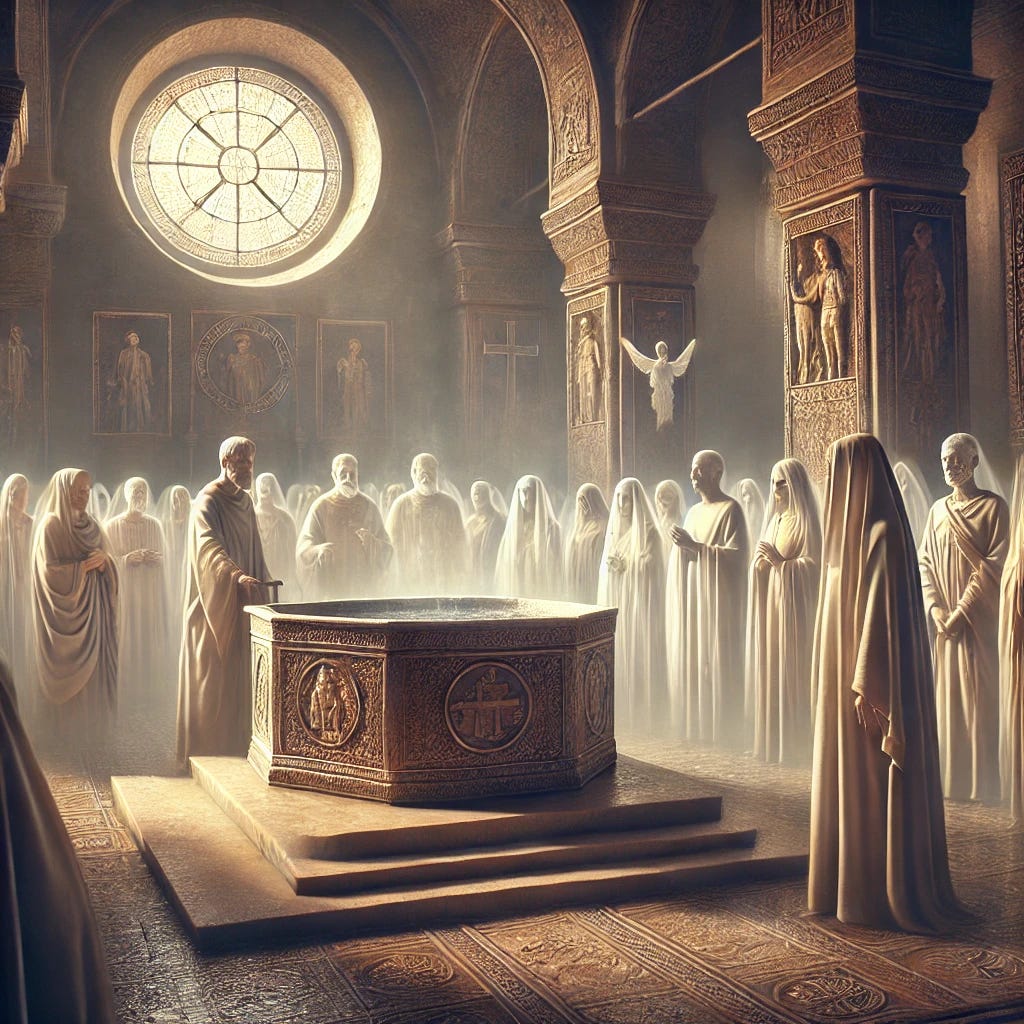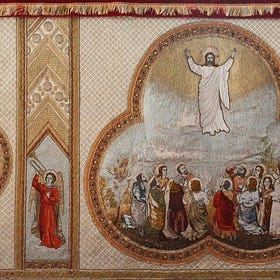7- Vicarious works for the Dead, LDS BELIEFS THAT MATTER
Valid ancient Christian practices or practices of ancient Gnostic heretics?
One of my subscribers asked me to write about Baptisms for the Dead, one of the more widely practiced and known LDS temple “sacraments,” also called “Vicarious works for the dead.”
It’s going to be impossible for me to cover this topic without a general explanation about these “ordinances” and without touching somewhat on the centuries-old argument for/against Sola-Fide.
Despite some of the critiques presented here, I think it is only fair to mention that I’m not opposed to these practices. This article is more of an exercise in critical thinking about them.
I should also reinforce that LDS people approach these rites with well-meaning, Christ-centered intentions, including love and sacrifice for both the living and the deceased. This article in no way means to take away from that. I still think these practices are beautiful expressions of love and devotion, and I appreciate the spirit in which they are performed. It was very moving for me when my son and I were able to perform these rites for my Grandfather after he passed away.
Salvation by Faith and Grace alone vs Works.
LDS vicarious works for the dead refer to religious practices performed by members of The Church of Jesus Christ of Latter-day Saints (LDS Church) on behalf of deceased individuals. These include baptisms, confirmations, and other ordinances (sacraments) performed in LDS temples. The belief behind these vicarious works is that deceased persons who did not have the opportunity to accept the gospel of Jesus Christ (as understood by Mormons) during their lifetime can receive these saving ordinances by proxy, allowing them the chance to accept or reject them in the afterlife. This practice is rooted in the LDS beliefs surrounding of the eternal nature of families and the opportunity for all souls to receive salvation. This may be difficult for many non-Mormons to understand as many protestants no longer even practice baptism - in fact, many teach that no sacraments are required at all - part of their historical belief in Sola Fide - that faith alone is necessary (A position that originates with Martin Luther.)
In fact, many online rebuttals against the LDS practice of baptism for the dead that I recently found contain some component of denying the need for baptism at all. Typically, these sacraments are rejected as worthless human “works.” However, From an Orthodox perspective, we would strongly argue against sola-fide as being non-biblical.
James 2:14-26 solidly refutes Sola-fide to the degree that Martin Luther wanted to remove the entire book of James from the protestant bible! Luther and other reformers removed other books from the Bible, so for him, this would have been just one more.
This video discusses why the Protestant Bible has so many fewer books than the Orthodox or Catholic Bibles. They also get into a discussion about Luther.
The vexing scripture from James is quoted below:
14 What doth it profit, my brethren, though a man say he hath faith, and have not works? can faith save him?
15 If a brother or sister be naked and destitute of daily food,
16 And one of you say unto them, Depart in peace, be ye warmed and filled; notwithstanding ye give them, not those things which are needful to the body; what doth it profit?
17 Even so faith, if it hath not works, is dead, being alone.
18 Yea, a man may say, Thou hast faith, and I have works: shew me thy faith without thy works, and I will shew thee my faith by my works.
19 Thou believest that there is one God; thou doest well: the devils also believe and tremble.
20 But wilt thou know, O vain man, that faith without works is dead?
21 Was not Abraham our father justified by works when he had offered Isaac his son upon the altar?
22 Seest thou how faith wrought with his works, and by works was faith made perfect?
23 And the scripture was fulfilled which saith, Abraham believed God, and it was imputed unto him for righteousness: and he was called the Friend of God.
24 Ye see then how that by works a man is justified, and not by faith only.
25 Likewise also was not Rahab the harlot justified by works, when she had received the messengers, and had sent them out another way?
26 For as the body without the spirit is dead, so faith without works is dead also.
"Not everyone who says to Me, 'Lord, Lord,' shall enter the kingdom of heaven, but he who does the will of My Father in heaven." The words of Christ as found in Matthew 7:21-23
"Then the King will say to those on His right hand, 'Come, you blessed of My Father, inherit the kingdom prepared for you from the foundation of the world: for I was hungry and you gave Me food; I was thirsty and you gave Me drink; I was a stranger and you took Me in.'" Matthew 25:21-46: The Parable of the Sheep and the Goats highlights the importance of actions (feeding the hungry, clothing the naked, etc.) in the final judgment.
In my opinion, while Luther strongly disliked the Papacy, he effectively established himself as the Pope of his own Church, a heretical schismatic sect, outside of the historical body of Christ. The other reformers did the same.
For the sake of fairness, Sola-Fide does have some scriptural support, but I believe that Martin Luther misunderstood it.
"For by grace you have been saved through faith, and that not of yourselves; it is the gift of God, not of works, lest anyone should boast." Ephesians 2:8-9
"Not by works of righteousness which we have done, but according to His mercy He saved us, through the washing of regeneration and renewing of the Holy Spirit." Titus 3:5
The priest that taught my catechism pointed out that “Works” here specifically refers to the “Works” and legalistic observances of the Mosaic Law, not the things Christ commanded us to do—of which Baptism for the remission of sins is most certainly one.
How can one get from the one kingdom to the other (vv. 1–7)? By the unity of grace, faith, and works (v. 9). Not that these are equal, for grace is uncreated and infinite, whereas our faith is limited and can grow; good works flow out of authentic faith. Works cannot earn us this great treasure—it is a pure gift—but those who receive this gift do good. We are not saved by good works, but for good works.
Nelson, Thomas. The Orthodox Study Bible: Ancient Christianity Speaks to Today's World (p. 1610). Thomas Nelson. Kindle Edition.
The footnote for Titus 3:5 reads
The washing of regeneration, baptism, and renewing of the Holy Spirit, chrismation, form a unity in our salvation, clear throughout the NT. Jesus taught we are born from above through “water and the Spirit” (Jn 3:5); Peter preached salvation in Christ through being “baptized” and receiving “the gift of the Holy Spirit” (Acts 2:38). Now Paul calls us to the washing of the water and the renewing of the Holy Spirit.
Nelson, Thomas. The Orthodox Study Bible: Ancient Christianity Speaks to Today's World (p. 1649). Thomas Nelson. Kindle Edition.
One analogy I’ve come across is that Grace is like sunlight and works are the things we do to put ourselves in a position that we can step into that light and be warmed by it.
For a longer and more detailed discussion on Sola Fide please see the following video
How do LDS Understand Baptism for the Dead and Why do they do it?
Let’s start by understanding the LDS mindset that begins with the premise that if you die without the proper sacraments (the LDS term would be - ordinances), particularly baptism and confirmation, then you cannot achieve salvation, and you will likely be separated from your family and loved ones in the next life if they do not end up in the same place you do. I’ve covered some of this before. If you are interested, I invite you to read the following articles below.
Theosis vs Exaltation
This is really the third post in a series that examines some core fundamental beliefs, specifically around the nature of God, the nature and purpose of man, and soteriology. In this article, we will give a high-level overview of what both religions believe is the ultimate purpose, or end goal, of mankind, where they are similar and where they may differ.
A Primer on Understanding the LDS Church and Cosmology for Non-Mormons
I wrote this article to address widespread misconceptions about Mormon beliefs. While I welcome informed criticism, as I have done in this publication, it frustrates me when people disparage religious groups, including Mormons, Buddhists, and Orthodox Christians, based on false and erroneous beliefs. It's important to me that critiques are rooted in acc…
The other underlying understanding is that all of these sacraments can only be done by the living. The dead cannot perform them, but the living can perform them on behalf of those who have died.
The role of Genealogy
However, you can’t just head off to a temple to perform these rites for just anyone, you need some information so you know who you are performing these ordinances for. You typically need the person’s full legal name, date and place of birth, date of death, and sometimes the names of their parents, spouse, and children (to perform “sealings” of families together.) This is the reason that the LDS church and Mormons are so focused on genealogy. One goal for every Mormon is to make sure that all of their ancestors have had these ordinances performed for them so that their entire lineage can be saved, sealed together, and exalted. One should note that these rituals can only be performed in an LDS temple, which is completely different from an LDS church.
The LDS “vicarious works for the dead” include:
Baptism
Confirmation (i.e. Chrismation)
Washing and Anointing - Preparatory for the Endowment (1 & 2 are required for Salvation)
The Endowment ( 3-5 are required for Exaltation, i.e., deification or theosis.)
Sealings (also referred to as Eternal or Celestial Marriage) - A Husband and Wife must both be Endowed before they can be sealed.
Understanding the Scriptural / Historical support LDS rely on
Many would ask, is this practice of Baptism for the Dead biblically supported? To which an informed, faithful LDS would point to 1 Corinthians 15:29.
“Otherwise, what will they do who are baptized for the dead, if the dead do not rise at all? Why then are they baptized for the dead?”
St. Paul - 1 Corinthians 15:29
Orthodox study bible footnote: “The meaning of baptized for the dead is much disputed. Many understand this as vicarious baptism of baptized Christians for deceased catechumens (investigators in LDS speak.) St. John Chrysostom considered it a derisive comment about the practices of the Marcionite heretics. Epiphanius says it refers to a practice of the followers of Cerinthus, another gnostic teacher.”
We should note that the Gnostics were declared Heretics, outside of the Body of Christ, and that an effort was made to stop their spread. Some, LDS scholars and apologists have pointed to the Shepherd of Hermas as lending Support to this practice. Note that this book of scripture was not included it in the New Testament as being Scripture appropriate for all Christians because:
Late Composition: While popular in the 2nd century, it was written later than the apostolic era (1st century), a key criterion for inclusion in the New Testament canon.
Questionable Authorship: The author, Hermas, is not identified as an apostle or someone with direct ties to Jesus, unlike the authors of most New Testament books.
1. Shepherd of Hermas: Author, Dates, and Exclusion from the Bible - Bart Ehrman
Theological Concerns: Some early church leaders found certain theological aspects of the Shepherd of Hermas problematic or inconsistent with established doctrine.
Lack of Universal Acceptance: Although the Shepherd of Hermas was widely read and respected in some early Christian communities, it did not achieve the same level of universal acceptance as the books that were ultimately included in the New Testament.
Canonization Process: The process of canonization, through which the books of the New Testament were officially recognized and accepted, was a complex and lengthy one, spanning several centuries. The Shepherd of Hermas was ultimately not included due to a combination of the aforementioned factors.
1. Biblical literature - Canonization, Texts, History | Britannica
There is another statement from the Shepherd of Hermas that I think is relevant to this discussion. LDS Apologist John Tvedtnes uses this as evidence of the validity of these practices: (Here Stone’s refer to followers of Christ and the Tower they are building is Christ’s Church.)
Why, sir,” I said, “did these stones ascend out of the pit, and be applied to the building of the tower, after having borne these spirits? “They were obliged,” he answered, “to ascend through water in order that they might be made alive; for, unless they laid aside the deadness of their life, they could not in any other way enter into the kingdom of God. Accordingly, those also who fell asleep received the seal of the Son of God. For,” he continued, “before a man bears the name of the Son of God he is dead; but when he receives the seal he lays aside his deadness, and obtains life. The seal, then, is the water: they descend into the water dead, and they arise alive. And to them, accordingly, was this seal preached, and they made use of it that they might enter into the kingdom of God.”
Other ways to understand Paul’s statement.
Saint John Chrysostom (347-407 AD), who opposed a literal reading of 1 Corinthians 15:29, explained Paul's mention of people being "baptized for the dead" as a reference to the profession of faith they made in their own future resurrection before being baptized.1
Epiphanius of Salamis (between 310 and 320 – 403) reported that he had heard it said that, among followers of Cerinthus, if one of them died before baptism, another was baptized in that person's name:
For their school reached its height in this country, I mean Asia, and in Galatia as well. And in these countries I also heard of a tradition which said that when some of their people died too soon, without baptism, others would be baptized for them in their names, so that they would not be punished for rising unbaptized at the resurrection and become the subjects of the authority that made the world.2
The Marcionite practice seems to have been similar:
If one of their followers who was being prepared for baptism died before receiving baptism, the dead person's corpse was addressed with the question whether he wished to be baptized, whereupon another answered affirmatively and was baptized for the dead person.
LDS apologists will use the above as proof that this was a valid first century Christian practise that was lost due to some Great and Total Apostasy. (Which I think is tosh.) Proof that it existed is not proof that it was considered a valid Christian practise, nor that the LDS practise is a valid and legitimate “restoration” of this ancient practise, nor that it has efficacy, and particularly when LDS practise differs from the historical practise which was limited to Catechumens.
Keep reading with a 7-day free trial
Subscribe to Latter-Day Saint to Orthodox to keep reading this post and get 7 days of free access to the full post archives.






